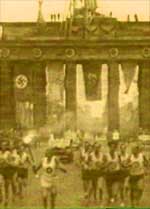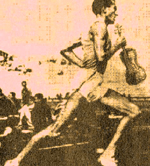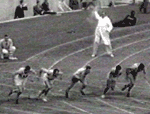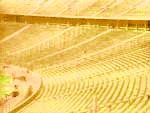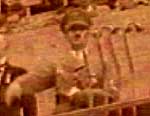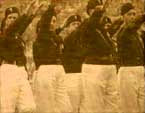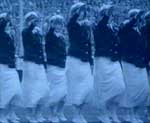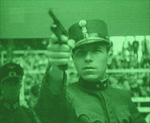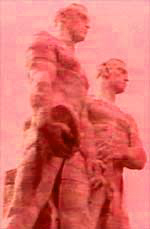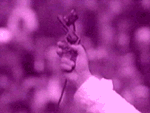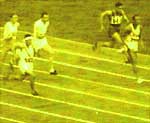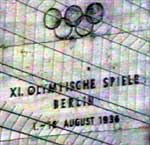 | |||||||

|
Sport & The Violin The Nazi Olympics |
|
|
As Dr. Rosenberg states in his book 'Killer Violin Exercises' from 1972: "The physicality of instrumental technique has long been considered a prime characteristic of improvised music. And so we find it hardly surprising that the contemporary musician is fascinated by the actions and rhythms of sport. Unfortunately sport also offers the leaders and perpetuators of the nation state the opportunity for, and the manipulation of, unlimited xenophobia. Although the Nazi Olympics of 1936 is perhaps the most extreme example of modern times, every leader strives for his 'golden' photo opportunity with the obliging sportsmen and women." As someone deeply affected and influenced by the writings of Rosenberg, Jon Rose has taken up the baton handed to him by his mentor. A number of sport pieces have appeared at regular intervals in the violinist's career. The amplified Squash game with violin obligato which took place at Praxis, Freemantle, Perth in 1983 found a structure suitable for the extended high speed music of that period. The Performance Space in Sydney in 1985 saw the infamous 'Relative Band plays Cricket' performances. It was quite a spectacle with amplified cricket bat; fully strung cricket stumps which caused massive feedback when knocked down by the quite accurate off spin bowling of JR himself; feminist commentary was provided by a young lady wearing a wedding dress; full teams of improvising musicians (the occasional drag queen); violin deconstructs specially designed for the cricket ritual; displaced audio crowds; and rain stop play every night (a journalist lost her camera in the flood). Then of course we arrive at the 'Olympic' pieces composed and performed in 1991-1993. These were performed at Varieté Chamaeleon, Berlin; Documenta 9, Kasel; The Post This and That Festival, Cologne; The Red Train Project, Germany; and for The ABC, Sydney. Using the original wax disc commentary from the Nazi Olympics (from the Sender Freies Berlin radio archive) and the 'Golden moments' from The Australian Broadcasting Corporation archive, these pieces set a new paradigm in music by the use of new interactive computer software and real world to MIDI interfaces... the measurement of athletic actions and gestures of sport could be converted into sound. Also the entire world of sound generated by sport could be sampled and used in real time music events. Examples of this are available on the 'Pulled Muscles' cd (Immigrant 019). I end by quoting the generous notes supplied to the live recordings but before I do I would urge the readers of this article to send their cheques to Jon Rose as he sets out on his next venture to wire up the Bondi Life Savers (that's right, a rowing to MIDI to sound to interactive video 'Iron man' pumping sextravaganza live on the beach at Bondi, Sydney). "In 1936, a fifteen year old musical prodigy arrived in Berlin to take part in the Olympic Games. He was part of the Australian team and although unknown in Europe, he had already developed quite a reputation in his native land as a teenage star of 'track and field violin'. Young Johannes Rosenberg had arrived straight from the outback with two exceptional talents - violin playing and running long distances, sometimes as simultaneous activities. The marathon was his natural distance which he used to run twice a day, to and from his violin lessons with Josef Kreisler (brother of the more famous Fritz) in the town of Wagga Wagga, New South Wales (population 301). But it had been decided, due to his tender age, that in Berlin he would run the 10,000 metres instead. 1936 was also the year that cultural events became an intricate part of the Olympic spectacle. A competition for music composition was inaugurated by Alfred Rosenkohl (N.B. Not another Rosenberg); a member of Hitler's euphonium guard and well known butterfly ace. The talented Australian decided to write a piece for violin and the sounds of sport in order to enter the competition. This was a rather naive idea as by the mid `30s in Germany, the violin was considered an instrument for the decadent, the mentally deranged and road sweepers. In the event, the score was confiscated by the Australian team manager (Fred Spokes) to prevent any political problems. The winner, by the way, was a set of variations on 'hörst du mein heimliches rufen' by Wilhelm Weisskopf. It was performed at the games closing ceremony by the massed euphoniums of the womens' swimming corps, Wansee. (Richard Strauss, of course, had composed the Olympic hymn for the opening ceremony of the games)." Fred Nooks, Sydney Morning Herald (23/4/1975) In an interview with 'The New York Times', some 30 years later, Rosenberg talked about his piece'The Athletic Violin'. 'The initial ideas came to me at the Berlin Olympics but somehow I didn't have the correct technology to realise the concept in terms of a performable experience. I was lucky that the piece got sabotaged! I had intended to record a part from each of the Olympic events on wax discs. Then each disc recording box would have been set up at 10 metre intervals, around the 400 metre running track in the stadium. Subsequently I would have run around the track playing violin in a sonic race with the disc recordings. I anticipated that each disc would be played manually by a practised team of musicians, thus there would have been the possibility for changing the speed of the sound; reversing it; selecting different parts of the recording; scratching the discs to cause repeating sections; etc. Each disc performer would have been sequenced and controlled by stop watches, thus allowing the cyclic affect in the stadium to mimic the discs - a macro reflecting a micro system. The violin, as indicator of the main time/distance relationship, was to have taken a free protagonistic position; a need for an improvisationary role in the proceedings. For me, this piece was the beginning of a series of pieces, in which I looked at the possibilities of COLLISION in music. Developing a language of Improvisation that would be able to deal with any sonic situation presented. Clearly, there is a simple link between sport and violin playing - and that is rhythm. But perhaps there is a more significant relationship and that is the physicality, something fundamental to Improvisation and Sport. Speed and Pain, as means of expression, are experiences that all sportspeople and violinpeople have in common'. Later in this interview, Rosenberg went on to talk about the research projects which he developed as a result of this early sports influence... 'The Walking Bass', for example. Compositions such as 'The Loneliness of The Long Distance Violinist' and his famous '4 Kilometers; 33 Meters' In the original instructions for 'The Athletic Violin', it was indicated that a third parameter of activity be included. This was to have been the simultaneous performance of 'The Deconstructed Coffee Cup'. As a believer in synchronicity, Rosenberg often included quotations from more popular musics - never concerning himself as to their relevance in any given situation. Having said that, the use of 'decomposed' caféhaus music from the 30's seems a masterstroke of atmospheric intervention. Rosenberg had to wait a full twenty years before the world premiere of 'The Athletic Violin'. It came with the Melbourne Olympic Games. A successful overseas career gave the maestro enough political pull to stage quite a spectacular version in Australia. The new technology of magnetic tape recorders replaced the old disc machines, just as Midi controlled sampling technology will replace the tape recorder in the coming Berlin performance. In spite of what happened before the competition in 1936, the violinist had gone ahead anyway and recorded some of the Olympic events. In the stadium he had disguised himself as a recording assistant for the German Broadcasting Service and made some discs of the long jump, shot and hundred meters final (The Jessie Owens Final). These historical documents will be utilised in a few weeks time, 55 years after their intended use, in the exact locations of the Olympic Stadium. And what happened in the 10,000 meters? As we all know now, Iimari Salminen of Finland won it in 30 minutes; 15 seconds; point 4. And what about the young Johannes Rosenberg? To this day nobody really knows the truth. The violinist says that somebody put something in his coffee. It's possible, there were drugs in sport then just like now (in fact The Rosenberg Museum now supports the mandatory use of drugs in all sports). Either way he failed to show up for the start of the race. By taking the wrong door from his changing rooms, he ended up in the finals of the Women's Diving Competition at the Olympic pool. There, seated on the end of the high diving board and, seemingly unaware of the public, proceeded to play the violin. He was temporarily arrested by the SS for performing the banned 'decadent music' (ie. all violin music). The Australian authorities sent him home on the next available ship out of Hamburg. Rosenberg says he doesn't remember anything about the incident. The newspapers had a field day. Johannes Odenthal, Australian Cultural Attaché Berlin, 1996 |
 |
